Charger Xtar VC4
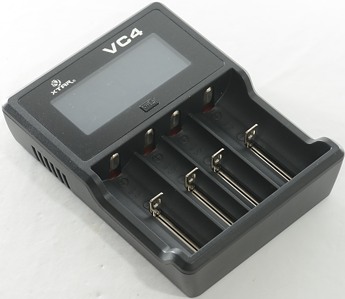

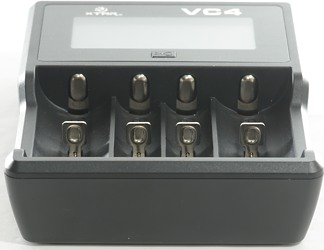
Xtar makes many LiIon chargers, this is a usb powered quad channel charger with display. The charger can charge with up to 1A for two channels or 0.5A for four channels, actual current depends on slots used and available usb power. It supports both NiMH and LiIon cells.




I got the charger in a cardboard box with the specifications printed on it.

Inside the box is a fabric bag with the charger in, this can be useful for traveling and to keep the manual, charger and cable together.

The bag contained the charger, a cable (charger to usb), a warranty card and a instruction manual.

The charger is usb powered, but the connector is a DC barrel connector, i.e. you need the supplied cable to connect the charger. I would have preferred the ability to use a normal usb cable. The DC barrel connector is not compatible with the one used on the 12V chargers, i.e. there is no risk of connecting a 12V power supply from another Xtar charger to this charger (Very good).
Another way to handle this would have been to make the charger accept both 5V and 12V power.
I got no USB power supply with the charger (Xtar say that they will also be selling a compatible usb power supply). I have tested some usb power supplies and it is possible to find a useable one on my list (Remember it must supply at least 2A for full charge speed).

There is a display, four red/green leds and one button. The button has a couple of functions:
1) Restore full background light on the display (The light will dim after a short time).
2) Turn the background light/display off or on, a long press will turn it off, any press will turn it on again.
3) Select what slots are displayed, this is only necessary if more than two batteries a charged simultaneous.
The leds are red while charging and green at all other times. This makes it very easy to see when a slot is finished.

The display uses dials to show voltage and maximum current, it does also have some 7 segment digits to show charged capacity and slot number.

The current dial only shows the maximum charge current, the actual current is lower when the battery is in the CV phase.
The voltage dials shows the actual voltage when in range:
0V Battery voltage is low, charger is only using low current, display may show "Err" if there is a problem with the batteries.
3.0V Voltage is high enough to start regular charge.
3.5V-4.2V Regular charge, display is within 0.1 volt.
If the charger only has two batteries in it, the display will always show them, independent of slots used, with 3 or 4 batteries the switch must be used to select between them.


The charger can handle both button top and flat top batteries.
The slider moves smoothly and can hand cells from 30mm to 71 mm long.



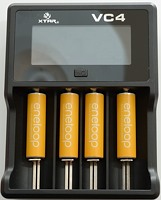


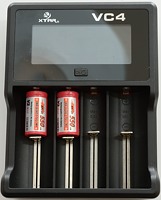




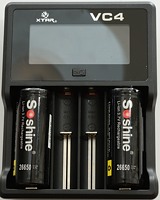

The charger can handle 71 mm long batteries, including flat top cells.
Measurements charger
- When charging the last digit in the capacity displays will flash.
- The charger will charge with 100mA from 0 volt and display will show NiMH
- Charger will not stop NiMH charging within the first 10 minutes.
- Above 2.0 volt the charger assumes LiIon battery.
- Between 2.0 volt and 2.9 volt charge current is 120mA on 1A range.
- Above 2.9 volt the full charge current will be applied.
- When charge is finished the charger will charge with 0.2mA.
- The charger steps charge current down when the usb voltage at the charger is below 4.7 volt.
- Charger will restart if voltage drops to 3.9 volt.
- Charge will restart charging after power loss, or battery insertion.
- When not connected to power it will drain about 0.6mA from a LiIon and 0.2mA from a NiMH battery.
- Current dial will show maximum possible charge current, not actual charge current.
- Voltage dial will show within 0.1 volt when voltage is in range.
- The 3 volt position on the voltage dial looks like it signals "start of regular charge", i.e. 2.9 volt.
- mAh display flashes "Full" when the corresponding battery is full.
- With only slot #1 and #4 in use maximum charger current is 1A
- With slot #2 or #3 in use all slots are limited to 0.5A charge current.
The light green line is usb current consumption, the dark green is charge current.
Charging LiIon
%20%231.png)
The charger does a nice CC/CV charge with a termination at about 70mA. The changing DC input current shows that this charger is using a switching charge regulator.
The display shows 2807mAh charged into the battery.
%20%232.png)
%20%233.png)
%20%234.png)
The other channels has a similar result. Slot #2 and #3 is charging with 0.5A. The termination current is the same on all slot at around 70mA
The display shows 2791mAh, 2776mAh and 2784mAh charged into the battery.
%20%231.png)
The 2600mAh battery has a long CV phase, probably because it is getting old.
The display shows 2172mAh charged into the battery.
%20%231.png)
The 3400mAh takes slightly longer to charge.
The display shows 3047mAh charged into the battery.
%20%232.png)
The charger has no problem with my old IMR cell, but there is not much capacity left in it.
The display shows 154mAh charged into the battery.
%20%232.png)
The 18350 cell is better, I uses slot #2 to limit the charger current to 0.5A
The display shows 695mAh charged into the battery.
%20%232.png)
The 14500 is also charged in slot #2
The display shows 754mAh charged into the battery.
.png)
Charging 4 LiIon cells at the same time is a rather slow, because the charger turns the charge current way down with my power supply and wires.
The display shows 2407mAh 2498mAh 2566mAh 2518mAh.
.png)
Increasing the usb voltage to 5.2V to compensate for wire losses improves the charge speed.
The display shows 2781mAh 2764mAh 2884mAh 2857mAh.
.png)
Supplying a falling voltage to the charger shows that the current regulation starts reducing the charge current rather soon, this is due to resistance in the cable and connection.

M1: 28,6°C, M2: 30,9°C, M3: 30,6°C, M4: 29,1°C, M5: 31,1°C, HS1: 37,1°C
The charger does not heat the batteries much during charge.
To do these photos I uses this usb power supply, it maintains the output voltage slightly above 5 volt, this allowed the charger to use full charge current.

M1: 28,2°C, M2: 30,0°C, M3: 30,0°C, M4: 28,1°C, HS1: 35,2°C
As usual the power connector get warm, but here the heat is very limited.

The charger needs about 10 seconds to start.

The 1A current is steady, no pulsing is used.

The 0.5A charge current is a reduction of charge current, not pwm regulation.
Charging NiMH
%20%231.png)
The charger was a bit doubtful about my 5 volt power supply and did reduce the charge current a couple of times.
The charging terminates on voltage and then does a top-off charge, as can be seen in some of the other curves this top-off takes about 2 hours. It is done after the charger reports done.
Display shows 1605mAh
%20%232.png)
%20%233.png)
The two 0.5A channels works the same way.
Display shows 1627mAh 1673mAh
%20%234.png)
The last channel accepts my power supply and uses full charge current all the time. On most of these charts it looks like the temperature is starting to raise, just before the charger terminates, this means the battery is fully charged.
Display shows 1661mAh
%20%231.png)
%20%231.png)
%20%231.png)
With these batteries the temperature raise is obvious.
Display shows 1750mAh 2312mAh 2209mAh
%20%232.png)
Here I am missing the temperature raise, i.e. the termination is a bit premature.
%20%231.png)
%20%232.png)
The charger can detect a full cell within a few minutes when it starts charging, but because the 10 minutes precharge it takes some time to detect the full cells.
.png)
With 4 cell the charger cannot get enough power from my 5 volt supply (due to cable and connection resistance), it need a bit more volt for full charge current.
Display shows 1676mAh 1683mAh 1746mAh 1720mAh
.png)
Raising the voltage a bit gets the charger up to full speed.
Display shows 18526mAh 1919mAh 1858mAh 1834mAh
.png)
Adding an extra 0.5ohm resistor in series with the power supply did not work, the charger needs a better power supply than that.

M1: 29,9°C, M2: 31,4°C, M3: 31,3°C, M4: 29,6°C, M5: 32,3°C, HS1: 38,7°C
Also NiMH cells stays very cool during charge.

For NiMH it takes 8 second from power on to precharge is started.

The precharge runs for 10 minutes, before regular charger kicks in.
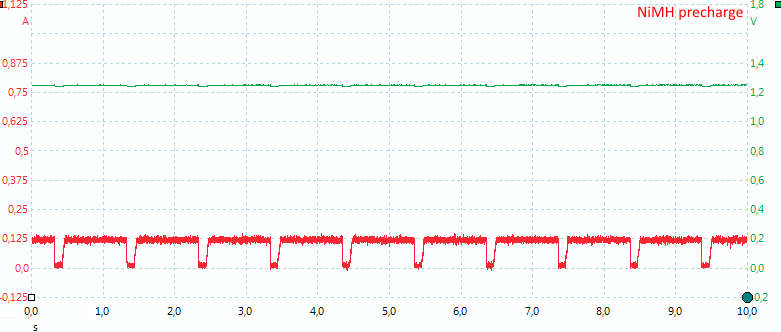
Precharge is about 120mA with pulsing each second.

1A charging has the same pulsing and uses 1A as charge current in the pulses, average charge current will be a bit lower due to the pulsing.

0.5A charging reduces the current, there is no pwm regulation.

The two hour top-off charge is done with pulses.

And the current depends on the charge current.
Charging LiIon and NiMH
Mixing LiIon and NiMH cells in the charger is no problem.
.png)
In the above curve I measure on the NiMH cell (Except temperature that is on a LiIon), the NiMH finished first.
.png)
In this curve the NiMH finished first (the DC input current drops) and I continue recording the LiIon data.
Because the charger is supplied from usb power there will not be any safety issues with it, but be careful with the usb power adapter.
Conclusion
The charger is very good at both LiIon and NiMH charging and keeps some impressive low cell temperature during charge (Like the VC2).
For charging at full current the charger is fairly demanding of the used usb power supply. It is possible to use weaker supplies, but the charging will be slower or sometimes much slower. With the current dial it is easy enough to see when that happens and it is time to get a better usb power supply. I would have liked slightly better performance with weak usb power supplies.
This type of charger is what I will call a family charger. Nearly anybody in the family can use it, just put the batteries into the charger and wait. Only caveat is that small batteries go into the two center slots or, for sets of four, in all four slots.
Final conclusion must be that it is a good charger.
Notes
The charger was supplied by XTAR for a review.
Here is an explanation on how I did the above charge curves: How do I test a charger

